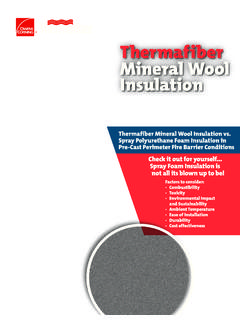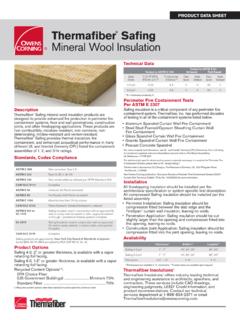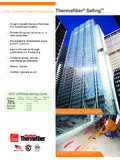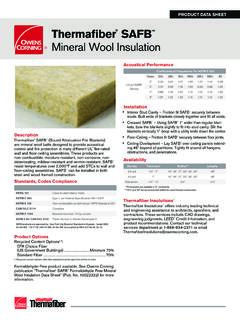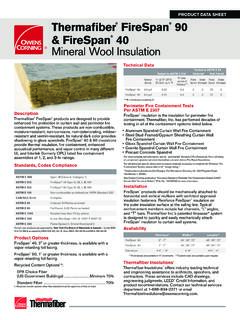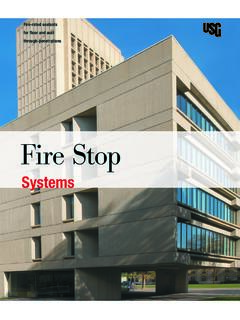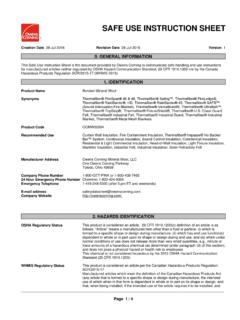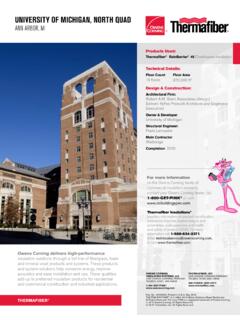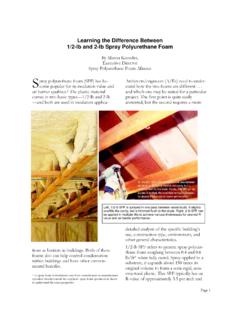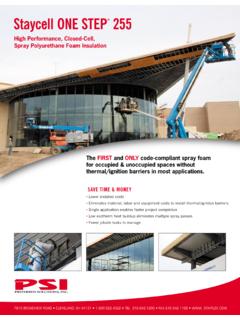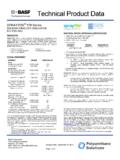Transcription of Thermafiber Mineral Wool Insulation
1 \\ \files\Workfolders\Michael\Active Jobs\PC Files\ Thermafiber -burnedCD\Brochures_09- 2013\10424-TFI_TF525 SprayFoamBrochure\PAGES\ February 13, 2014 9:31 AM Page 3T hermafiber Mineral wool InsulationFactors to consider: Combustibility Toxicity Environmental Impact and Sustainability Ambient Temperature Ease of installation Durability Cost effectivenessCheck it out for foam Insulation is not all its blown up to be! Thermafiber Mineral wool Insulation vs. Spray Polyurethane foam Insulation in Pre-Cast Perimeter Fire Barrier Conditions\\ \files\Workfolders\Michael\Active Jobs\PC Files\ Thermafiber -burnedCD\Brochures_09- 2013\10424-TFI_TF525 SprayFoamBrochure\PAGES\ February 13, 2014 9:31 AM Page 4 Thermafiber Mineral wool vs.
2 Spray foam Insulation (closed cell): a head-to-head comparisonCompare Thermafiber Mineral wool to Spray foam Insulation (Closed Cell). Compare the efficiency. Compare fire protection. Compare aesthetics. Compare prices, too. Whatever your criteria, the more you compare, the more benefits you ll find with Mineral WoolCharacteristicSpray foam Insulation (Closed Cell) Thermafiber Mineral wool Insulation resists temperatures in excess of 2,000 F per ASTM E Fire Resistivity The flash point of Spray Polyurethane foam (SPF) is approximately 392 Some SPFs can be treated with halogenated fire retardants, however, the additives only delay the time to flash and ultimately increase the toxicity of smoke when subjected to high Also fire retardant properties deteriorate with is made from inorganic materials (rock and blast furnace slag), therefore it is naturally noncombustible.
3 Thermafiber products are classified as non-combustible per ASTM E Polyurethane Foams (SPF) are highly combustible and present dangers during building renovation. Renovation can leave SPF exposed to fire sources such as wires, torch flames, welding arcs, trash fires, and other potential fire hazards. There have been several fires where combustible construction components contributed to fire spread and loss of life in Selecting non-combustible materials reduces ignition risks. Mineral wool is naturally fire retardant and does not require a thermal Barrier ProtectionBecause of its high combustibility characteristics, the codes require that SPF be separated from the building interior by a 15-minute thermal SPF Insulation manufacturers are specific about which type of thermal barrier is acceptable for their individual products.
4 This requires additional research and sourcing of material in choosing the appropriate thermal barrier, and additional labor cost to install. Thermafiber unfaced Insulation has Flame Spread and Smoke Developed ratings of 0. Foil-faced Mineral wool products have a Flame Spread of 25 and Smoke Developed of 0. These ratings are classified per ASTM E Burning Characteristics per ASTM E 84 SPF manufacturers report surface burning characteristics as high as Flame Spread of 25 and Smoke Developed 450 (4 thick).7 When ignited, SPF releases large quantities of intense, thick and highly toxic smoke3 such as hydrogen cyanide, carbon monoxide, amines and Thermafiber Mineral wool Insulation has been tested as a proven firestopping material in numerous perimeter fire containment designs including the precast exterior wall condition.
5 UL Design CW-D-2005 provides a 2 hour rating with Mineral wool Safing Insulation in the safe-off void. Along with the Mineral wool Insulation in the safe-off area, the precast panel joints are also required to be firestopped with an approved system such as WW-S-0038 to prevent flame spread through small joints in precast panels at the safing Perimeter Fire Barrier SystemsSPF has not been tested in perimeter fire barrier systems and is not an approved material in these designs. Applications of SPF to the precast wall typically does not include the protection of the precast panel joints. Systems such as WW-S-0038 are required to keep fire from spreading vertically through the joints.
6 Not only does the SPF product add a significant fuel source to fire, excluding the protection of the precast joints will allow fire to spread vertically through the safe-off area, negating the hourly rating of the assembly. Fire Performance Characteristics\\ \files\Workfolders\Michael\Active Jobs\PC Files\ Thermafiber -burnedCD\Brochures_09- 2013\10424-TFI_TF525 SprayFoamBrochure\PAGES\ February 13, 2014 9:31 AM Page 5 Thermafiber Mineral WoolCharacteristicSpray foam Insulation (Closed Cell) Thermafiber Mineral wool Insulation has consistent R-values per thickness regardless of installation temperatures.
7 R-values of Mineral wool Insulation are also not affected by aging. Although Thermafiber products do have a lower R-value per inch versus aged R-values of SPF, this can be offset with increased thickness and still be more cost effective than foam s much ambiguity surrounding published R-values for SPF. Some SPF Insulation manufacturers publish aged R-values from to per inch. However, there are many factors that can degrade the R-value such as installation temperature, temperature of substrate, and inconsistencies in applied thickness. Also variables such as humidity levels can affect the quality of the foam and cause reductions in foil faced curtain wall Insulation offers a permeability rating of perms (grains/hr/ft2/in Hg) regardless of the thickness of material.
8 Underwriter Laboratories perimeter fire containment system, CW-D-2006, does not compromise the continuity of the vapor barrier since Safing Insulation is installed between the slab edge and a foil faced Firespan 90 Insulation . Continuity of Vapor BarrierSPF insulations offer permeability ratings of less than 1. However, the rating is dependent on the applied thickness. The perm rating thickness requirement varies from one manufacturer to another. Therefore, if required thickness is not correctly applied, the perm rating would be compromised. In perimeter wall conditions where Safing Insulation is installed as a perimeter fire barrier system, SPF Insulation sprayed above and below the Safing Insulation (if applied in correct thickness) will provide a vapor barrier.
9 However, the portion of the exterior wall assembly behind Safing Insulation , where foam is not applied, does not have a vapor barrier. Therefore the continuity of the vapor barrier is compromised in assemblies using SPF Insulation at the exterior precast Mineral wool Insulation requires only minimal PPE (Personal Protection Equipment). PPE such as safety glasses, gloves, long sleeves and dust mask are worn to avoid temporary skin and eye irritation which generally diminishes quickly after ceasing installation. Mineral wool Insulation has been extensively researched for many years by leading laboratories and universities in the and abroad.
10 Scientific research shows no association between exposure to rock/slag fibers and respiratory disease or cancer in Information on the health and safety of the product can be found in the MSDS, or by viewing the Health and Safety of Mineral wool Fibers at Mineral wool Insulation is stable and does not require certified SafetySPF Insulation is a hazardous product and when not handled properly, according to the EPA and OSHA, is a leading attributable cause of occupational Methylene Diphenyl Diisocyanate (MDI) in vapors, aerosols, and dust can trigger severe or fatal asthma attacks in sensitized persons at very low levels.
